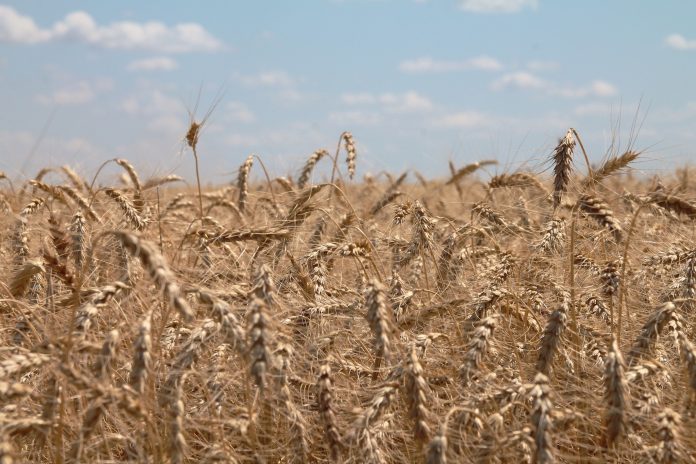By Carol Mowdy Bond
Contributing Writer
A fourth generation Yukon area wheat farmer, Jerry Lingo said, “This year’s wheat crop has the potential to be the best crop in four or five years. But you don’t know until you get it in the grain bin, aka elevated. A storm could come through and wipe it all out tonight.”
Lingo is out checking all his wheat fields. He said, “Wheat has to be a certain moisture before elevators will take it. Ours is too wet right now. It’s a natural drying down process. It’s not mature enough yet. So, I haven’t started my harvest yet. But it will be ready soon.”
“Wheat prices aren’t very good now,” said Lingo. He has 15,000 to 16,000 acres of wheat fields in the Banner and El Reno areas, and he takes his wheat to the Banner Co-Op Elevator, 4175 N. Banner Road in El Reno, and the Schroeder Grain Elevator, 620 S. Evans Avenue in El Reno.

Lingo also has 700 to 800 head of cattle. “The cattle market is terrible,” said Lingo who runs his cattle in his wheat fields. “If you’re running your cattle in your wheat fields, every year at the first of May, cattle won’t eat the wheat because the quality goes down then. You’ve got to either put the cattle in another field, or if you don’t have another field, you have to sell the cattle. When it’s time to sell, you’ve got to, because you have no other field to put them in. So, you’re at the market’s mercy.”
This spring, Lingo had no choice but to sell some of his cattle. But because of the COVID-19 impact on the market, Lingo sold them at low prices.
Mike Schulte, executive director of the Oklahoma Wheat Commission, 8820 Silver Hill Drive in Oklahoma City, said, “We’re in wheat harvest right now. Right now the USDA has us set to come in for harvest for the state at 102.6 million bushels. The ten year average for Oklahoma is 101 million bushels as an average for the state. But if you are in southwest Oklahoma near the Oklahoma-Texas line, south of I-40, we could see major freeze damage in that part of the state. They will likely only take in about 1/3 of the crop in that region.”
“In central and north Oklahoma, we’ve had good growing weather and rain and temperatures,” said Schulte.
Schulte said wheat harvest is going on now in Canadian County, and things look good in the areas of Yukon, Piedmont, and Okarche. “Right now, over all, we’re seeing fairly decent yield,” said Schulte. “We’re getting a lot of reports of 40 bushels per acre and mid-50 bushels per acre in this region. As we go north, things may be better.”
As for the western region of the state, Schulte said, “In the areas around Rocky and Sentinel, they didn’t get enough moisture early on, and they had a late freeze, so the crop was impacted. This has made it more of a challenge.”

Schulte said the state’s panhandle has some good areas, but some areas are drought stricken.
He also said he’s hearing good reports of good kernel size. But he said, “Proteins are all over the road. I think the quality overall for this crop, we’ll have high test rates. High test rates indicate better performance in the mills. You have tests on proteins. They help with the functionality. That’s what buyers look at when purchasing. We won’t have an extremely high or low protein crop this year. It will be average.”
As for what millers and bakers want, Schulte believes the quality will be good.
But Schulte said for the last two years, some wheat producers have faced challenges. “But the export market shipments have increased to China,” he said. “We’ll have a good crop for exports. I hope we’ll continue to have the export region of China.
Now we have a trade agreement.”

Just like other markets, “COVID-19 has impacted the overall situation with wheat,” said Schulte. “There’s been a 3 to 4% flour consumption increase in the last three months.
What consumers want has changed. And due to social distancing that naturally occurs with how our stuff functions, we have not seen issues in our industry with COVID-19,” said Schulte. “With that being said, we are trying to stay ahead of the issue. We are fully aware that it only takes one person to get COVID-19, and that would cause an issue. So, in the elevator industry, the collection points have been different as the crops come in. Truck drivers are not currently allowed to get out of their trucks at all at Oklahoma elevators.”
Schulte said the commission released a statement to the production facilities and wheat farmers about COVID-19.
The statement included information about washing hands, wearing masks, symptoms of the illness, and how to prevent the spread.
“I don’t think we know how the markets will shake out in the next 10 to 12 months. I don’t have a crystal ball. A lot of factors impact prices at the end of the day. I like to remain hopeful.”






